Sustainability of Cocoa (Theobroma cacao) Cultivation in the Mining District of Ponce Enríquez: A Trace Metal Approach
Abstract
1. Introduction
2. Materials and Methods
2.1. Study Area
2.2. Field Sampling
2.3. Laboratpry Analysis
2.4. Data Analysis
3. Results
3.1. Metal Content
3.2. Mobility Analysis
3.3. Risk Analysis
4. Discussion
5. Conclusions
Author Contributions
Funding
Institutional Review Board Statement
Informed Consent Statement
Data Availability Statement
Acknowledgments
Conflicts of Interest
References
- Zúñiga, A. Riqueza, prestigio y ofrenda divina: Los usos del cacao en el mundo nahua. Hosp. ESDAI 2020, 37, 35–54. [Google Scholar]
- Vassallo, M. Diferenciación y agregado de valor en la cadena ecuatoriana del cacao. Inf. Investig. 2016, 1, 23–43. [Google Scholar]
- Abad, A.; Acuña, C.; Naranjo, E. El cacao en la Costa ecuatoriana: Estudio de su dimensión cultural y económica. Estud. Gestión. Rev. Int. Adm. 2020, 7, 59–83. [Google Scholar]
- Gunson, A.J.; Marcello, M. Mercury and artisanal mining in China. Environ. Pract. 2004, 6, 109–120. [Google Scholar] [CrossRef]
- Lozada, D. La Conminución en la Minería Pequeña y Artesanal en Ecuador. Available online: https://www.researchgate.net/publication/292983759 (accessed on 3 May 2022).
- Ecuador, E.L.; Tributario, R.A.; De, R.R.; Interno, R.T.; Los, R.R. Ley Reformatoria Para la Equidad Tributaria del Ecuador; Asamblea Constituyente, 2008. Available online: https://www.gob.ec/sites/default/files/regulations/2018-11/ley%20equidad.pdf (accessed on 3 May 2022).
- Betancourt, Ó.; Barriga, R.; Davée, J.; Cueva, E.; Betancourt, S. Impacts on Environmental Health of Small-Scale Gold Mining in Ecuador. Ecohealth Res. Pract. 2012, 1, 119–130. [Google Scholar]
- Evaluación del Marco de Políticas Mineras del IGF. Available online: https://www.iisd.org/system/files/publications/ecuador-mining-policy-framework-assessment-es.pdf (accessed on 12 April 2022).
- Carling, G.T.; Diaz, X.; Ponce, M.; Perez, L.; Nasimba, L.; Pazmino, E.; Rudd, A.; Merugu, S.; Fernandez, D.P.; Gale, B.K.; et al. Particulate and dissolved trace element concentrations in three southern Ecuador rivers impacted by artisanal gold mining. Water Air Soil Pollut. 2013, 224, 1415. [Google Scholar] [CrossRef]
- Duguma, B.; Gockowski, J.; Bakala, J. Desafíos biofísicos y oportunidades para el cultivo sostenible de cacao (Theobroma cacao Linn.) en sistemas agroforestales de Africa Occidental y Central. Rev. Agroforestería Américas 1999, 6, 7–10. [Google Scholar]
- Pantoja, F.H.; Pantoja, S.D. Problemas y desafíos de la minería de oro artesanal y en pequeña escala en Colombia. Rev. Fac. Cienc. Económicas 2016, 24, 147–160. [Google Scholar]
- Velásquez-López, P.C.; López, I.Y.; Rivera, M.F. Estimation of the ecological and human health risk of mercury in a mangrove area of the La Puntilla estuary, El Oro province, southern Ecuador. Bol. Investig. Mar. Costeras 2020, 49, 81–100. [Google Scholar] [CrossRef]
- Challenger, A.; Dirzo, R. Tendencias de cambio y estado de la biodiversidad, los ecosistemas y sus servicios. Factores Cambio Estado Biodivers. 2009, 11, 205–210. [Google Scholar]
- Barraza, F.; Schreck, E.; Lévêque, T.; Uzu, G.; López, F.; Ruales, J.; Prunier, J.; Marquet, A.; Maurice, L. Cadmium bioaccumulation and gastric bioaccessibility in cacao: A field study in areas impacted by oil activities in Ecuador. Environ. Pollut. 2017, 229, 950–963. [Google Scholar] [CrossRef]
- Casteblanco, J.A. Heavy metals remediation with potential application in cocoa cultivation. Granja 2018, 27, 21–35. [Google Scholar] [CrossRef]
- Williams, M. Algunas aplicaciones de la información geoquímica de la cordillera occidental del Ecuador. In Geoquímica y Ambiente, 1st ed.; UPC PRODEMINCA: Guayas, Ecuador, 2001; pp. 82–86. [Google Scholar]
- Muhammad, M.; Shah, T.; Khan, S. Health risk assessment of heavy metals and their source apportionment in drinking water of Kohistan region, northern Pakistan. Microchem. J. 2011, 98, 334–343. [Google Scholar] [CrossRef]
- Mesa-Pérez, M.; Díaz-Rizo, O.; Tavella, M.; Baqué, D.; Sanchez-Pérez, J. Soil-to-Plant Transfer Factors of Rare Earth Elements in Rice (Oryza sativa L.). Rev. Cienc. Técnicas Agropecu. 2018, 27, 2071-0054. [Google Scholar]
- Onyele, O.; Anyanwu, E. Human Health Risk Assessment of Some Heavy Metals in a Rural Spring, Southeastern Nigeria. Afr. J. Environ. Nat. Sci. Res. 2018, 1, 15–23. [Google Scholar]
- Londoño, L.; Londoño, P.; Muñoz, F. Los Riesgos de los Metales Pesados en la Salud Humana y Animal. Biotecnoloía Sect. Agropecu. Agroind. 2016, 14, 145–153. [Google Scholar] [CrossRef]
- De Araujo, Q.R.; Baligar, V.C.; Loureiro, G.D.A.; de Souza Júnior, J.O.; Comerford, N.B. Impact of soils and cropping systems on mineral composition of dry cacao beans. J. Soil Sci. Plant Nutr. 2017, 17, 410–428. [Google Scholar] [CrossRef][Green Version]
- Mensah, E.; Kyei-Baffour, N.; Ofori, E.; Obeng, G. Influence of human activities and land use on heavy metal concentrations in irrigated vegetables in Ghana and their health implications. Appropr. Technol. Environ. Prot. Dev. World 2009, 1, 9–14. [Google Scholar]
- Cuenca, G.; Cáceres, A.; Oirdobro, G.; Hasmy, Z.; Urdaneta, C. Las micorrizas arbusculares como alternativa para una agricultura sustentable en áreas tropicales. Interciencia 2007, 32, 23–29. [Google Scholar]
- Román-Ochoa, Y.; Choque, G.; Tejada, T.; Yucra, H.; Durand, A.; Hamaker, B. Heavy metal contamination and health risk assessment in grains and grain-based processed food in Arequipa region of Peru. Chemosphere 2021, 274, 129792. [Google Scholar] [CrossRef]
- Handojo, L.; Triharyogi, H.; Indarto, A.; Indarto, A. Residuos de cáscara de grano de cacao como materia prima potencial para el polvo de fibra dietética. Int. J. Recycl. Org. Waste Agric. 2019, 8, 485–491. [Google Scholar] [CrossRef]
- Hosseini, S.; Gallart, M.; Singh, K.; Hannet, G.; Komolong, B.; Yinil, D.; Field, D.; Muqaddas, B.; Wallace, H. Leaf litter species affects decomposition rate and nutrient release in a cocoa plantation. Agriculture. Ecosyst. Environ. 2022, 324, 107705. [Google Scholar]
- Ghosh, M.; Singh, S. A review on phytoremediation of heavy metals and utilization of it’s by products. Asian J. Energy Environ. 2005, 6, 214–231. [Google Scholar]
- Guerra Sierra, B.E.; Muñoz Guerrero, J.; Sokolski, S. Phytoremediation of Heavy Metals in Tropical Soils an Overview. Sostenibilidad 2021, 13, 2574. [Google Scholar] [CrossRef]
- Ntiamoah, A.; Afrane, G. Environmental impacts of cocoa production and processing in Ghana: Life cycle assessment approach. J. Clean. Prod. 2008, 16, 1735–1740. [Google Scholar] [CrossRef]
- Sandeep, G.; Vijayalatha, K.R.; Anitha, T. Metales pesados y su impacto en cultivos hortícolas. Rev. Int. Estud. Químicos 2019, 7, 1612–1621. [Google Scholar]
- Kacmaz, H. Assessment of heavy metal contamination in natural waters of Dereli, Giresun: An area containing mineral deposits in northeastern Turkey. Environ. Monit. Assess. 2020, 192, 91. [Google Scholar] [CrossRef]
- Malone, A.; Smith, N.; Zeballos, E. Coexistence and conflict between artisanal mining, fishing, and farming in a Peruvian boomtown. Geoforum 2021, 120, 142–154. [Google Scholar] [CrossRef]
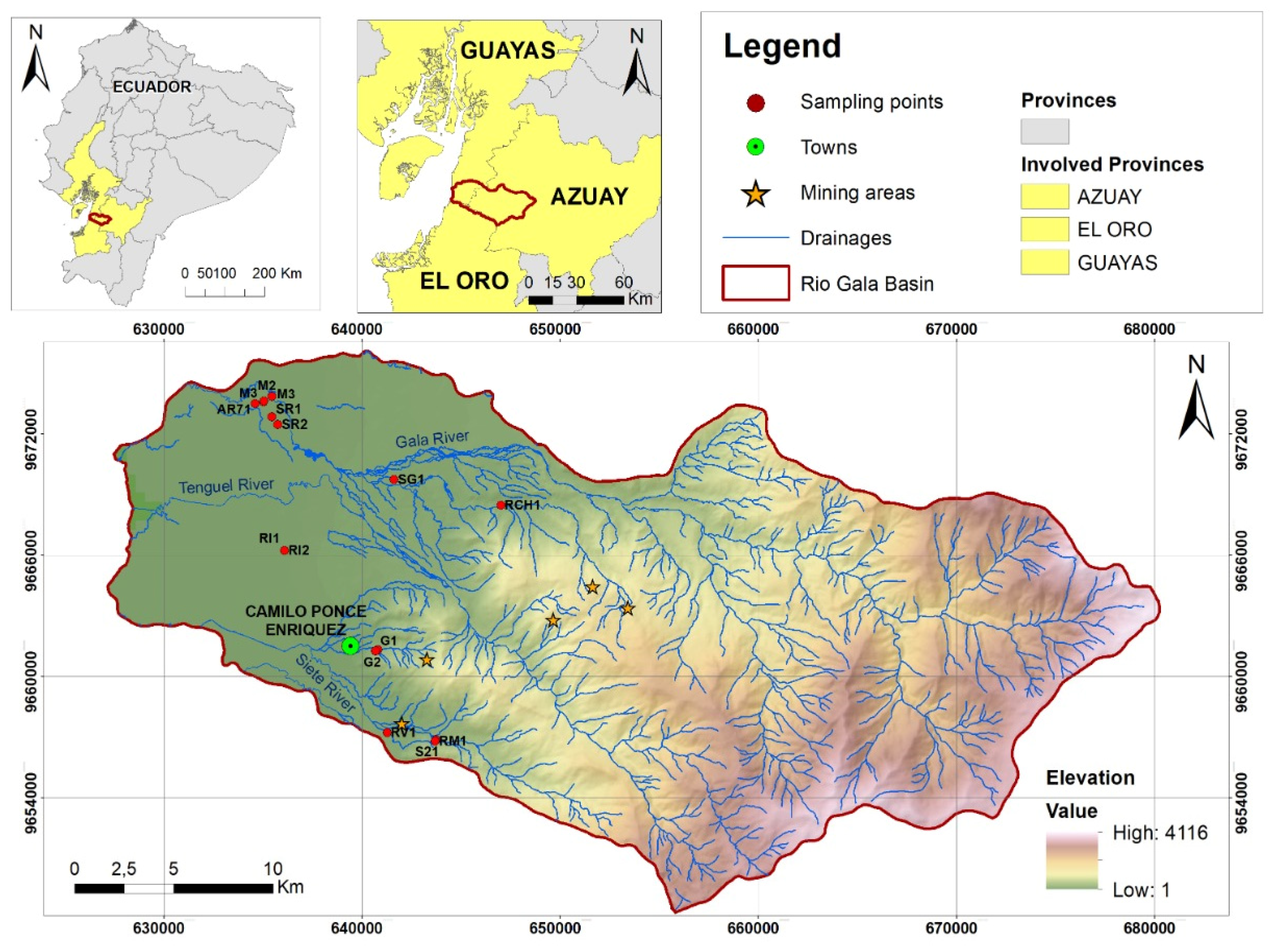
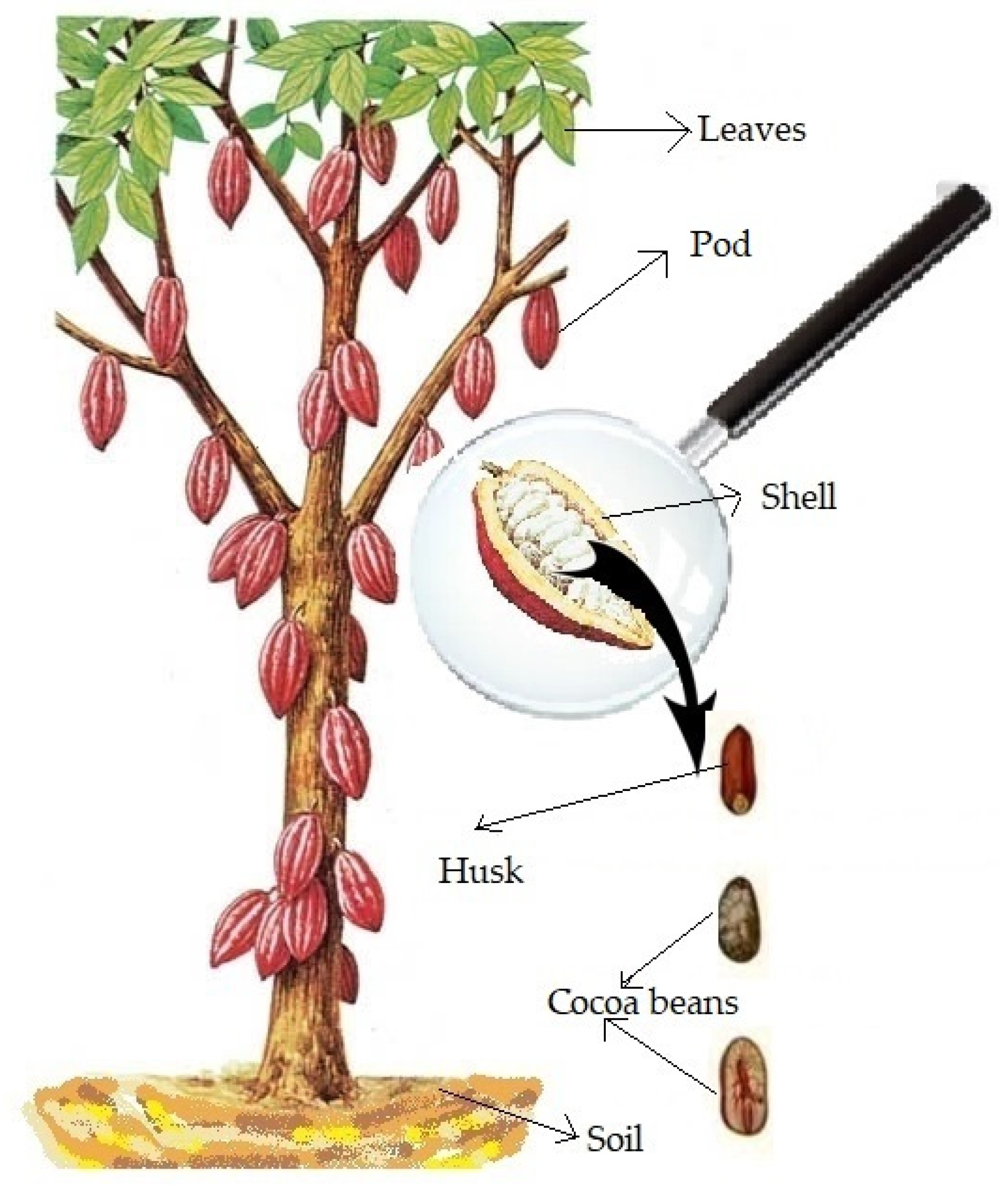
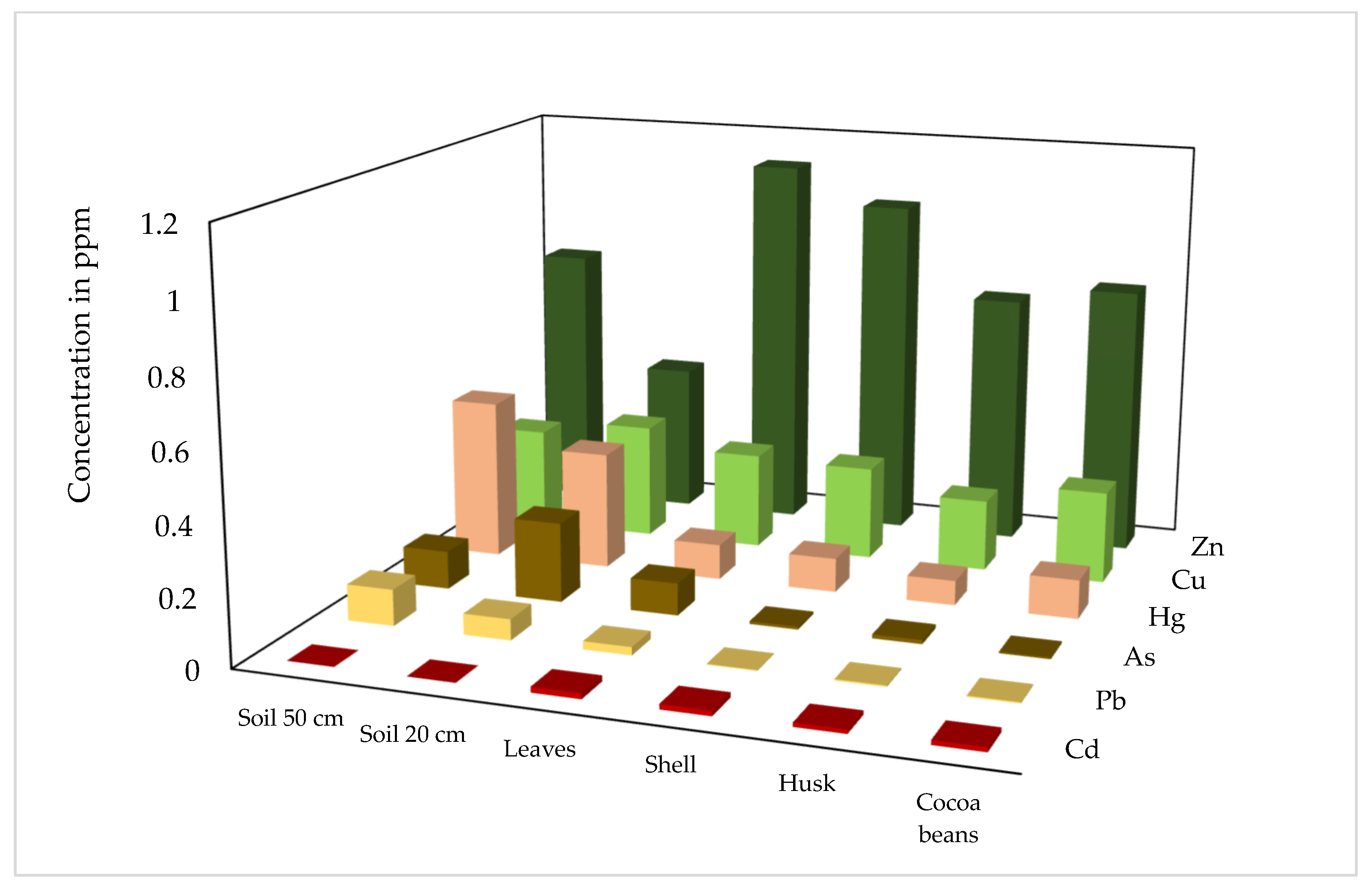

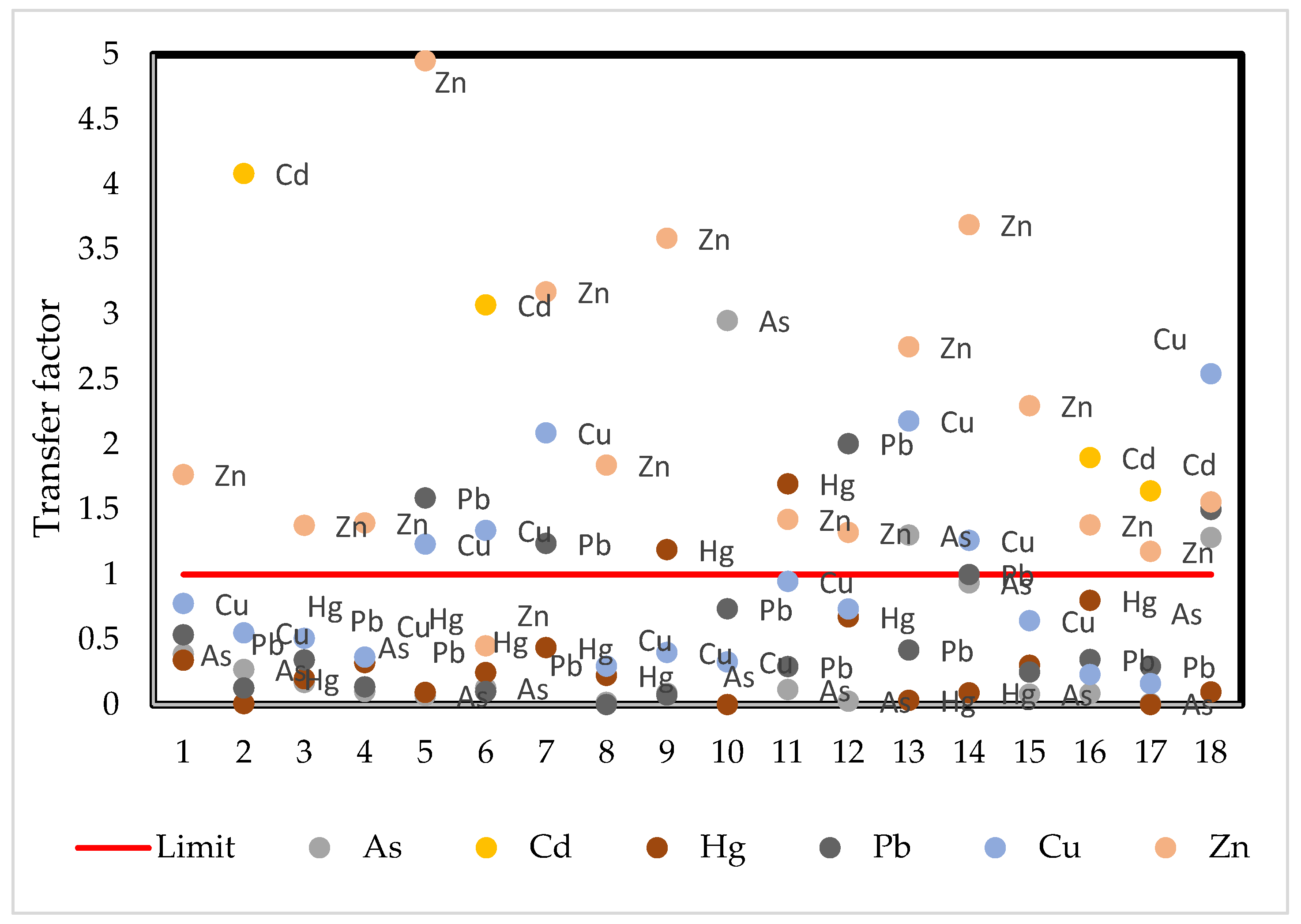
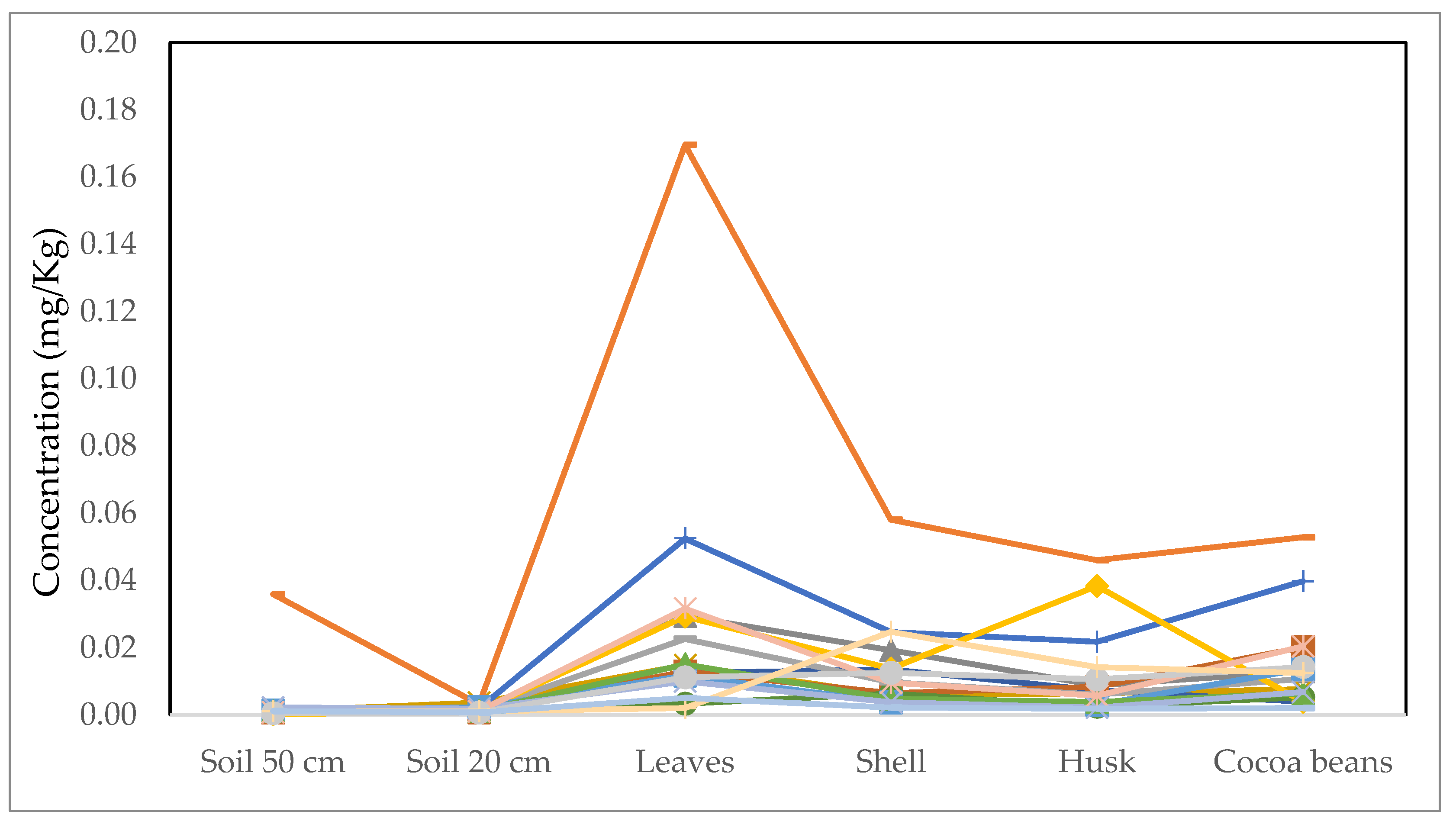

| Cd | Pb | |
|---|---|---|
| (µg/L) | 1.31 × 10−5 | 3.56 × 10−6 |
| IDU Adults | 1.07 × 10−5 | 2.91 × 10−6 |
| CDI Children | 5.84 × 10−5 | 1.58 × 10−5 |
| RfD (mg/(kg-day)) | 5 × 10−4 | 3.5 × 10−3 |
| HQ Adults | 2.14 × 10−2 | 8 × 10−4 |
| HQ kids | 11.67 × 10−2 | 4.5 × 10−3 |
Publisher’s Note: MDPI stays neutral with regard to jurisdictional claims in published maps and institutional affiliations. |
© 2022 by the authors. Licensee MDPI, Basel, Switzerland. This article is an open access article distributed under the terms and conditions of the Creative Commons Attribution (CC BY) license (https://creativecommons.org/licenses/by/4.0/).
Share and Cite
Ramos, C.; Ruales, J.; Rivera-Parra, J.L.; Sakakibara, M.; Díaz, X. Sustainability of Cocoa (Theobroma cacao) Cultivation in the Mining District of Ponce Enríquez: A Trace Metal Approach. Int. J. Environ. Res. Public Health 2022, 19, 14369. https://doi.org/10.3390/ijerph192114369
Ramos C, Ruales J, Rivera-Parra JL, Sakakibara M, Díaz X. Sustainability of Cocoa (Theobroma cacao) Cultivation in the Mining District of Ponce Enríquez: A Trace Metal Approach. International Journal of Environmental Research and Public Health. 2022; 19(21):14369. https://doi.org/10.3390/ijerph192114369
Chicago/Turabian StyleRamos, Carolina, Jeny Ruales, José Luis Rivera-Parra, Masayuki Sakakibara, and Ximena Díaz. 2022. "Sustainability of Cocoa (Theobroma cacao) Cultivation in the Mining District of Ponce Enríquez: A Trace Metal Approach" International Journal of Environmental Research and Public Health 19, no. 21: 14369. https://doi.org/10.3390/ijerph192114369
APA StyleRamos, C., Ruales, J., Rivera-Parra, J. L., Sakakibara, M., & Díaz, X. (2022). Sustainability of Cocoa (Theobroma cacao) Cultivation in the Mining District of Ponce Enríquez: A Trace Metal Approach. International Journal of Environmental Research and Public Health, 19(21), 14369. https://doi.org/10.3390/ijerph192114369








